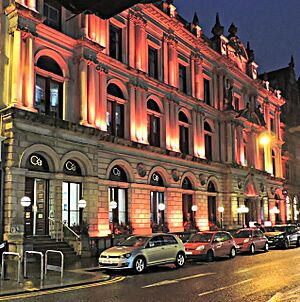Clydesdale Bank facts for kids

Former historic headquarters of Clydesdale Bank on St Vincent Place, Glasgow
|
|
| Trading name | |
| Industry | Banking, Financial services |
| Founded | 2 March 1838 May 1838 (official opening) |
| Headquarters | Glasgow, Scotland, UK |
|
Key people
|
James Pettigrew (Chairman) Chris Rhodes (Chief Executive Officer) |
| Services | Retail banking SME banking |
| Revenue | See Parent company |
|
Operating income
|
See Parent company |
| See Parent company | |
| Total assets | See Parent company |
|
Number of employees
|
See Parent company |
| Parent | Clydesdale Bank plc |
Clydesdale Bank (Scottish Gaelic: Banca Dhail Chluaidh) is a well-known bank in Scotland. It is a part of a bigger company called Clydesdale Bank plc. This bank helps people and businesses with their money. They offer services like saving, spending, and loans.
In June 2018, the company that owned Clydesdale Bank, called CYBG, bought another bank named Virgin Money. This was a big deal worth £1.7 billion. The plan was to eventually use the Virgin Money name for all their banking services. This included changing the parent company's name to Virgin Money UK plc. Clydesdale Bank, along with Yorkshire Bank and Virgin Money, still operate under the same banking license in Scotland.
Contents
History of Clydesdale Bank
Clydesdale Bank first opened its doors in May 1838. It was founded in Glasgow, Scotland. Over the years, it grew to become a very important bank in Scotland. It has helped many people and businesses with their financial needs.
Scottish Banknotes
Banks in Scotland have a special right to print their own banknotes. This is different from England and Wales. In those countries, only the Bank of England prints banknotes. In Scotland, Clydesdale Bank, the Royal Bank of Scotland, and Bank of Scotland still print their own money.
After the company that owned Clydesdale Bank bought Virgin Money in 2018, there was a plan to use the Virgin Money brand more. However, it was decided that Virgin Money would continue to issue banknotes under the Clydesdale brand. This means you can still see Clydesdale Bank notes today.
Banknote Designs: 2009 Series
The banknotes currently in use were first released in autumn 2009. The front of these notes features famous Scottish people. The back of the notes shows UNESCO World Heritage Sites in Scotland. These are special places recognized for their cultural or natural importance.
| Image | Value | Main Colour | Design | |||
|---|---|---|---|---|---|---|
| Front | Back | Front Design | Back Design | |||
| [1] | [2] | £5 | Blue | Sir Alexander Fleming | St Kilda | |
| [3] | [4] | £10 | Brown | Robert Burns | Edinburgh Old and New Towns | |
| [5] | [6] | £20 | Purple | King Robert the Bruce | New Lanark | |
| [7] | [8] | £50 | Green | Elsie Inglis | The Antonine Wall | |
| [9] | [10] | £100 | Red | Charles Rennie Mackintosh | Neolithic Orkney | |
Older Banknote Series
Before the 2009 series, Clydesdale Bank notes also featured important Scottish figures. For example:
- A £5 note showed Robert Burns, a famous poet.
- The £10 note featured Mary Slessor, a missionary.
- A £20 note had Robert the Bruce, a Scottish king.
- The £50 note showed Adam Smith, an economist.
- A £100 note featured Lord Kelvin, a scientist.
Adam Smith is also on the £20 note issued by the Bank of England. This makes him the only person to appear on banknotes from two different British banks.
Special Commemorative Banknotes
Sometimes, Clydesdale Bank issues special banknotes. These are called commemorative notes. They are made to celebrate important events or famous people. Collectors often look for these notes, so they do not stay in circulation for long.
Some examples of these special notes include:
- A £5 note in 1996 to celebrate the poetry of Robert Burns.
- A £10 note in 1997 to honor the work of Mary Slessor.
- A £20 note for the Commonwealth Heads of Government Meeting in Edinburgh in 1997.
- A £20 note in 1999 to mark Glasgow as the UK City of Architecture and Design. This note featured architect Alexander Thomson.
- A £20 note to celebrate 700 years since Robert the Bruce became king.
- A £10 note in 2006 to mark the bank's support for the Scottish Commonwealth Games team.
- A £5 note in 2015 featuring engineer Sir William Arrol and the Forth Bridge. This note was special because it was made of plastic.
Polymer Banknotes
In March 2015, Clydesdale Bank became the first bank in Great Britain to issue polymer banknotes. These are banknotes made of a special type of plastic. The £5 note celebrating the Forth Bridge was the first of these. They are more durable and have new security features.
While Clydesdale Bank was the first in Great Britain, other banks in the UK had issued plastic notes before. For example, the Northern Bank in Northern Ireland issued polymer £5 notes in 1999. The Bank of England also started issuing polymer £5 notes in September 2016.
Supporting the Commonwealth Games
In March 2005, Clydesdale Bank became an official partner of the Scottish Commonwealth Games Team. This was for the 2006 Commonwealth Games held in Melbourne, Australia. The bank also released special Ten Pound (£10) notes with a Commonwealth Games theme for the event.
See also
 In Spanish: Banco Clydesdale para niños
In Spanish: Banco Clydesdale para niños
- List of banks in the United Kingdom
- Banknotes of the pound sterling

